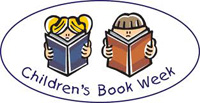 The 94th annual celebration of Children's Book Week is May 13-19, 2013. Established in 1919, Children's Book Week is the longest-running national literacy initiative in the country. Children's Book Week is administered by Every Child A Reader. The International Reading Association's Children's Literature and Reading Special Interest Group (CL/R SIG) celebrates Children's Book Week with this list of lovely new books.
The 94th annual celebration of Children's Book Week is May 13-19, 2013. Established in 1919, Children's Book Week is the longest-running national literacy initiative in the country. Children's Book Week is administered by Every Child A Reader. The International Reading Association's Children's Literature and Reading Special Interest Group (CL/R SIG) celebrates Children's Book Week with this list of lovely new books.
GRADES K-2
Delacre, Lulu. (2013). How far do you love me? Text translated from Spanish by Veronica Betancourt. New York: Lee & Low Books.
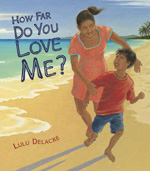 Using soft pastels and free style poetic language, the author/illustrator has depicted the love of parent/adult and child using examples from all seven continents. Beginning with the question of “How far do you love me?” (p.1) and answering with “I love you to the top of the peaks/lit by the morning sun…” (p.2) from the Grand Canyon in Arizona, USA, and continuing with “To the depths of the cave/where a spring seeps sweet water …” from Cenote Dzitnup, Yucatán, México. Other geographic comparisons representing the depth of parental love include Machu Picchu, Peru; the Antarctic Peninsula; the Serengeti Plain, Tanzania; the Siani Peninsula, Egypt; Provence, France; the Alps in Switzerland; Ladakh in the Himalaya Mountains in India; the Mekong River, Vietnam; Kangaroo Island, Australia; the Great Barrier Reef in Australia; and Vieques, Puerto Rico. The book concludes with a map of the world with each location mentioned pinpointed and an invitation from the author to play this game with a favorite child.
Using soft pastels and free style poetic language, the author/illustrator has depicted the love of parent/adult and child using examples from all seven continents. Beginning with the question of “How far do you love me?” (p.1) and answering with “I love you to the top of the peaks/lit by the morning sun…” (p.2) from the Grand Canyon in Arizona, USA, and continuing with “To the depths of the cave/where a spring seeps sweet water …” from Cenote Dzitnup, Yucatán, México. Other geographic comparisons representing the depth of parental love include Machu Picchu, Peru; the Antarctic Peninsula; the Serengeti Plain, Tanzania; the Siani Peninsula, Egypt; Provence, France; the Alps in Switzerland; Ladakh in the Himalaya Mountains in India; the Mekong River, Vietnam; Kangaroo Island, Australia; the Great Barrier Reef in Australia; and Vieques, Puerto Rico. The book concludes with a map of the world with each location mentioned pinpointed and an invitation from the author to play this game with a favorite child.
- Karen Hildebrand, Ohio Library and Reading Consultant
Duval, Kathy. (2013). Take me to your BBQ. Illus. by Adam McCauley. New York: Disney/Hyperion Books.
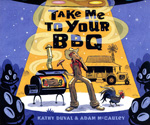 “Some colored lights from outer space/ Are lightin’ up the whole dang place!” (p. 5) says Willy from his Texas-style ranch while he watches little green men emerge from their space ship once they finish landing on his place. The aliens run around the ranch and get a feel for the garden and tractors and the food. Willy gets out his fiddle, and the aliens enjoy square dancing and the Texas two-step, and then the fun really begins. He fires up the grill, and the aliens commence to pour BBQ sauce on everything – beans, taters, greens, even Willy’s hat and shoes. McCauley’s watercolors and pastels add to the hilarity of the story in the depiction of the aliens and the havoc they create. A surprising twist at the end occurs when Willy and a few farm pets leave in the space vehicle UFO to fly to worlds beyond and open Willy’s BBQ, seen on an appropriate pull-out double page spread in the homeland of the aliens. Several wordless pictures end the book as readers see that a few green men have stayed behind and are taking care (or are they?) of the ranch. There is even a yummy BBQ sauce recipe included on the final pages. Enjoy McCauley’s website where he provides examples that trace how these final pictures evolved. The author has created a detailed teacher’s guide at her website.
“Some colored lights from outer space/ Are lightin’ up the whole dang place!” (p. 5) says Willy from his Texas-style ranch while he watches little green men emerge from their space ship once they finish landing on his place. The aliens run around the ranch and get a feel for the garden and tractors and the food. Willy gets out his fiddle, and the aliens enjoy square dancing and the Texas two-step, and then the fun really begins. He fires up the grill, and the aliens commence to pour BBQ sauce on everything – beans, taters, greens, even Willy’s hat and shoes. McCauley’s watercolors and pastels add to the hilarity of the story in the depiction of the aliens and the havoc they create. A surprising twist at the end occurs when Willy and a few farm pets leave in the space vehicle UFO to fly to worlds beyond and open Willy’s BBQ, seen on an appropriate pull-out double page spread in the homeland of the aliens. Several wordless pictures end the book as readers see that a few green men have stayed behind and are taking care (or are they?) of the ranch. There is even a yummy BBQ sauce recipe included on the final pages. Enjoy McCauley’s website where he provides examples that trace how these final pictures evolved. The author has created a detailed teacher’s guide at her website.
- Karen Hildebrand, Ohio Library and Reading Consultant
Houran, Lori Haskins. (2013). I will keep you safe and sound. Illus. by Petra Brown. New York: Scholastic Press.
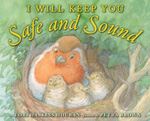 This beautifully illustrated and endearing rhymed story arrives just in time for Mother’s Day. The title comes from the three sections of the book that speak to parental love and keeping children safe and sound, beginning with “Brown bears in the den/ While the first buds peep/” (p.3), continuing with “Rabbits in the field/While the crickets cheep/” (p.5), and concluding with “Robins in the nest/ While the rain pours down/ I will keep you safe and sound.” (p.7). The spare rhyming pattern continues with examples of alligators and the sun, squirrels and hawks, dolphins and wild waves, beavers and strong winds, ponies and the setting sun, and a kitten lost in the moonlight. Pencil, watercolor and gouache artwork give the illustrations a soft and warm invitation to very young readers for a lap story safe within the arms of a loving adult. Listen to the illustrator read the book at her website with her delightful British accent.
This beautifully illustrated and endearing rhymed story arrives just in time for Mother’s Day. The title comes from the three sections of the book that speak to parental love and keeping children safe and sound, beginning with “Brown bears in the den/ While the first buds peep/” (p.3), continuing with “Rabbits in the field/While the crickets cheep/” (p.5), and concluding with “Robins in the nest/ While the rain pours down/ I will keep you safe and sound.” (p.7). The spare rhyming pattern continues with examples of alligators and the sun, squirrels and hawks, dolphins and wild waves, beavers and strong winds, ponies and the setting sun, and a kitten lost in the moonlight. Pencil, watercolor and gouache artwork give the illustrations a soft and warm invitation to very young readers for a lap story safe within the arms of a loving adult. Listen to the illustrator read the book at her website with her delightful British accent.
- Karen Hildebrand, Ohio Library and Reading Consultant
Kleven, Elisa. (2013). Cozy light, cozy night. Berkeley, CA: Creston Books.
 Filled with luminously colored and vividly detailed illustrations, this picture book in rhyming text celebrates that feeling of coziness so often associated with family and home. As the seasons change over the course of the year, all sorts of objects, including dreams, cocoa, birds, sweaters, and apples are described as being cozy. Although it’s wonderful to feel secure and cozy at any time of the year, youngsters experiencing tough times may find solace in this lovely, heartfelt book. There is little doubt that anyone reading this book won't relate to some of the different objects and relationships that spell coziness for the narrator.
Filled with luminously colored and vividly detailed illustrations, this picture book in rhyming text celebrates that feeling of coziness so often associated with family and home. As the seasons change over the course of the year, all sorts of objects, including dreams, cocoa, birds, sweaters, and apples are described as being cozy. Although it’s wonderful to feel secure and cozy at any time of the year, youngsters experiencing tough times may find solace in this lovely, heartfelt book. There is little doubt that anyone reading this book won't relate to some of the different objects and relationships that spell coziness for the narrator.
- Barbara A. Ward, Washington State University Pullman
Levine, Arthur A. (2013). The very beary tooth fairy. Illus. by Sarah S. Brannen. New York: Scholastic Press.
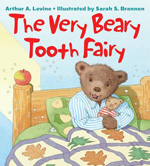 Every child worries about losing his/her first tooth and wondering about the tooth fairy, and Zach the bear is no different. As he struggles with his loose tooth, it is finally when his sister Leah shares a bag of candy that the tooth comes out. Zach has been trying to figure out if the tooth fairy is a bear or if the fairy is human and whether he should be afraid or not. His mother assures him that all will be just fine because “A bear can be anyone/ And anyone can be a bear” (p.14). That night when Zach hides his tooth, two interesting events occur. Dressed in fairy clothing (it’s sister Leah, really) when Zach is mostly asleep, she slips into his room and leaves an apple for his prize. After Leah leaves and Zach nods off and falls asleep, the “real” tooth fairy complete with wings and wand and fairy dust arrives to find the real tooth and leave a dollar, spritz Zach’s human doll into a teddy bear, and his picture of baseball great Sandy Koufax into a bear baseball player. The magic of the tooth fairy remains a mystery!
Every child worries about losing his/her first tooth and wondering about the tooth fairy, and Zach the bear is no different. As he struggles with his loose tooth, it is finally when his sister Leah shares a bag of candy that the tooth comes out. Zach has been trying to figure out if the tooth fairy is a bear or if the fairy is human and whether he should be afraid or not. His mother assures him that all will be just fine because “A bear can be anyone/ And anyone can be a bear” (p.14). That night when Zach hides his tooth, two interesting events occur. Dressed in fairy clothing (it’s sister Leah, really) when Zach is mostly asleep, she slips into his room and leaves an apple for his prize. After Leah leaves and Zach nods off and falls asleep, the “real” tooth fairy complete with wings and wand and fairy dust arrives to find the real tooth and leave a dollar, spritz Zach’s human doll into a teddy bear, and his picture of baseball great Sandy Koufax into a bear baseball player. The magic of the tooth fairy remains a mystery!
- Karen Hildebrand, Ohio Library and Reading Consultant
Reid, Barbara. (2013). Picture a tree. Park Ridge, IL: Albert Whitman & Company.
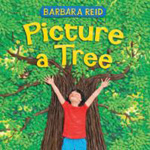 Filled with powerful language, this appealing picture book encourages readers to look at trees from many different perspectives. Once they have done so, the author writes, "You may see the end of one thing, or the start of something new" (unpaged). Young readers will appreciate the author's consideration of trees in so many creative, even playful ways while older readers may be reminded of A Tree Is Nice (1956) by Janice May Udry, which covers similar territory. Both books are filled with splashes of green that soothe the senses and make readers pause for a moment. Certainly visually attractive, the Plasticine illustrations are filled with colors and plenty of movement. The images and text in this book also gladden the heart and may prompt meandering journeys through the trees during which hikers may store up sensory images so that they can truly picture a tree when they return home.
Filled with powerful language, this appealing picture book encourages readers to look at trees from many different perspectives. Once they have done so, the author writes, "You may see the end of one thing, or the start of something new" (unpaged). Young readers will appreciate the author's consideration of trees in so many creative, even playful ways while older readers may be reminded of A Tree Is Nice (1956) by Janice May Udry, which covers similar territory. Both books are filled with splashes of green that soothe the senses and make readers pause for a moment. Certainly visually attractive, the Plasticine illustrations are filled with colors and plenty of movement. The images and text in this book also gladden the heart and may prompt meandering journeys through the trees during which hikers may store up sensory images so that they can truly picture a tree when they return home.
- Barbara A. Ward, Washington State University Pullman
Moore, Eva. (2013). Lucky ducklings. Illus. by Nancy Carpenter. New York: Orchard Books.
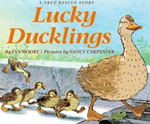 Of course this true story of the stranded ducklings in Montauk, New York, in 2000, begs to be used with Robert McCloskey’s Make Way for Ducklings. Carpenter’s wonderful illustrations give several perspectives from the ducklings’ point of view to add to the suspense. Mama Duck has decided to take her new little ducklings for a walk and as she quacks out orders to follow her, Pippin, Bippin, Tippin, Dippin, and Little Joe, do just that. They leave the park and nibble on things to eat while on their walk. As Mama Duck continues their walk she marches right over the storm drain, and all of the little ducklings fall through the grate! The little ducklings create quite a ruckus. Fortunately, someone sees what is happening, and although firemen are called to the rescue, they can’t get the grate off. “That could have been the end of the story. But it wasn’t, because ….” (p.16) a man named Perry attaches a cable from his truck and is able to pull the grate off. A wonderful perspective of the fireman crawling down into the storm drain as the little ducks are looking up from the dark is the centerpiece of this story. The ducks are rescued and placed in a bucket to be taken to the pond. But Mama Duck is not happy about that! “Fireman Dennis knows just was to do” (p.21). He removes the ducklings from the bucket and lets them line up with Mama, stops traffic, and allows the ducks to travel on their way. For more background on this author and this true story, read this Q&A interview from Publisher’s Weekly.
Of course this true story of the stranded ducklings in Montauk, New York, in 2000, begs to be used with Robert McCloskey’s Make Way for Ducklings. Carpenter’s wonderful illustrations give several perspectives from the ducklings’ point of view to add to the suspense. Mama Duck has decided to take her new little ducklings for a walk and as she quacks out orders to follow her, Pippin, Bippin, Tippin, Dippin, and Little Joe, do just that. They leave the park and nibble on things to eat while on their walk. As Mama Duck continues their walk she marches right over the storm drain, and all of the little ducklings fall through the grate! The little ducklings create quite a ruckus. Fortunately, someone sees what is happening, and although firemen are called to the rescue, they can’t get the grate off. “That could have been the end of the story. But it wasn’t, because ….” (p.16) a man named Perry attaches a cable from his truck and is able to pull the grate off. A wonderful perspective of the fireman crawling down into the storm drain as the little ducks are looking up from the dark is the centerpiece of this story. The ducks are rescued and placed in a bucket to be taken to the pond. But Mama Duck is not happy about that! “Fireman Dennis knows just was to do” (p.21). He removes the ducklings from the bucket and lets them line up with Mama, stops traffic, and allows the ducks to travel on their way. For more background on this author and this true story, read this Q&A interview from Publisher’s Weekly.
- Karen Hildebrand, Ohio Library and Reading Consultant
Scillian, Devin. (2013). Johnny Kaw: A tall tale. Illus. by Brad Sneed. Ann Arbor, MI: Sleeping Bear Press.
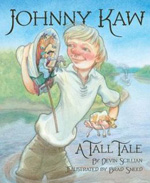 The author has written a tall tale reminiscent of Paul Bunyan although this tale centers around life on the plains of Kansas. Told in rhyming lines, the story begins when Johnny is born, and as he turns five minutes old, he is already six foot two and gains a pound every hour. Very soon, his parents have to find a bigger place to live. As they leave their home, Johnny literally helps them carve out a new place to live by throwing the stones from the field, and in true tall tale fashion the stones become the Rocky Mountains. He spits out a seed of grass and fields of wheat grow. When a cyclone twister whips up, Johnny goes after that storm with his newly created scythe made from a cottonwood trunk and a windmill blade. Life is going well until Johnny’s mother passes away. To deal with his grief, “he cleared every tree and left Kansas bare/ So she could see the sunset from anywhere” (p.27) because watching the sunset was his mother’s favorite time of day. This is a tenderly told story that will add humor and perspective to any tall tale collection of stories.
The author has written a tall tale reminiscent of Paul Bunyan although this tale centers around life on the plains of Kansas. Told in rhyming lines, the story begins when Johnny is born, and as he turns five minutes old, he is already six foot two and gains a pound every hour. Very soon, his parents have to find a bigger place to live. As they leave their home, Johnny literally helps them carve out a new place to live by throwing the stones from the field, and in true tall tale fashion the stones become the Rocky Mountains. He spits out a seed of grass and fields of wheat grow. When a cyclone twister whips up, Johnny goes after that storm with his newly created scythe made from a cottonwood trunk and a windmill blade. Life is going well until Johnny’s mother passes away. To deal with his grief, “he cleared every tree and left Kansas bare/ So she could see the sunset from anywhere” (p.27) because watching the sunset was his mother’s favorite time of day. This is a tenderly told story that will add humor and perspective to any tall tale collection of stories.
- Karen Hildebrand, Ohio Library and Reading Consultant
Scillian, Devin. (2013). Memoirs of a hamster. Illus. by Tim Bowers. Ann Arbor, MI: Sleeping Bear Press.
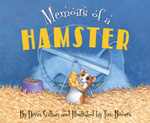 From the author of Memoirs of a Goldfish (2010) comes the “Question: Who’s the luckiest hamster in the world? Answer: ME!” (p.1). And so begins the writing pattern of this delightful story that must be read aloud for full enjoyment. Each page tells the story of Seymour’s arrival to his new home with Little Girl. Even though she likes to kiss him (Yuck!), he does enjoy his new water bottle, and his Fuzzy Boy 360 exercise wheel, and he really likes the yogurt drops that Little Girl feeds him. However, Pearl the cat questions Seymour’s enjoyment of his wheel since it doesn’t go anywhere, and tells him that the freedom of the sun room and the stairway made of sunflower seeds are a much more enjoyable way of living. As Seymour thinks Pearl might be right, he devises a plan to escape from his cage. Pearl is anxiously waiting to attack on the night of Seymour’s escape, and as Seymour realizes what could be first but fatal mistake, he asks: “Question: Who’s in big trouble? Answer: ME!” For any child who has had or wanted a hamster, this very funny story with a bit of suspense is just right for sharing with others. Read more about the author in "5 Questions With...Devin Scillian" on the Engage blog.
From the author of Memoirs of a Goldfish (2010) comes the “Question: Who’s the luckiest hamster in the world? Answer: ME!” (p.1). And so begins the writing pattern of this delightful story that must be read aloud for full enjoyment. Each page tells the story of Seymour’s arrival to his new home with Little Girl. Even though she likes to kiss him (Yuck!), he does enjoy his new water bottle, and his Fuzzy Boy 360 exercise wheel, and he really likes the yogurt drops that Little Girl feeds him. However, Pearl the cat questions Seymour’s enjoyment of his wheel since it doesn’t go anywhere, and tells him that the freedom of the sun room and the stairway made of sunflower seeds are a much more enjoyable way of living. As Seymour thinks Pearl might be right, he devises a plan to escape from his cage. Pearl is anxiously waiting to attack on the night of Seymour’s escape, and as Seymour realizes what could be first but fatal mistake, he asks: “Question: Who’s in big trouble? Answer: ME!” For any child who has had or wanted a hamster, this very funny story with a bit of suspense is just right for sharing with others. Read more about the author in "5 Questions With...Devin Scillian" on the Engage blog.
- Karen Hildebrand, Ohio Library and Reading Consultant
Sheth, Kashmira. (2013). Tiger in my soup. Illus. by Jeffrey Ebbeler. Atlanta: Peachtree Press.
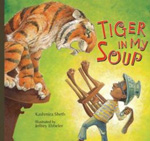 Perfect for Children’s Book Week, Right to Read Week, El Dia, or any day to commemorate literacy, this book celebrates reading. An older sister left in charge of her younger brother must get his lunch ready to eat. Busily occupied with her own book, she distractedly warms up soup for her brother’s lunch and ignores his pleas to read to him. When the soup is plopped on the table, steamy and too hot to start slurping it down, the young boy is startled as a tiger lunges out of the soup. At every turn, the boy is faced with the ferocious tiger, while his sister sees and hears nothing. The illustrations exaggerate the tiger’s size and fierceness as well as the fear on the young boy’s face, and prompt chuckles from readers. Much of the unspoken fun is in the pictures.
Perfect for Children’s Book Week, Right to Read Week, El Dia, or any day to commemorate literacy, this book celebrates reading. An older sister left in charge of her younger brother must get his lunch ready to eat. Busily occupied with her own book, she distractedly warms up soup for her brother’s lunch and ignores his pleas to read to him. When the soup is plopped on the table, steamy and too hot to start slurping it down, the young boy is startled as a tiger lunges out of the soup. At every turn, the boy is faced with the ferocious tiger, while his sister sees and hears nothing. The illustrations exaggerate the tiger’s size and fierceness as well as the fear on the young boy’s face, and prompt chuckles from readers. Much of the unspoken fun is in the pictures.
- Karen Hildebrand, Ohio Library and Reading Consultant
Van Lieshout, Maria. (2013). Flight 1-2-3. San Francisco: Chronicle Books.
 Young readers are always fascinated with transportation. “When taking a flight, what do you see?” is the author’s introductory statement when readers open the book and begin a journey to the airport. Designed as a counting book, the book’s text encourages readers to begin with the number 1 and a sign for an airplane. The bold illustrations depict a young family getting out of their taxi as they arrive at the airport. Number 2 designates the sign for luggage carts, and the family uses two of them to move within the airport. Number 3 depicts the Check-In desks as the three passengers get their tickets. Number 4 shows the signs for elevators and escalators, number 5 depicts trash cans, Number 6 shows the security officers, Number 7 is for food and drinks, Number 8 and 9 show the restrooms, Number 10 represents the Gates. Large numbers are included at the end for seat belts signs, numbers representing miles and kilometers, feet and meters. This is a perfect travel companion to the author’s earlier book, Backseat A-B-See. Read more about her writing ideas for this book at the author’s blog.
Young readers are always fascinated with transportation. “When taking a flight, what do you see?” is the author’s introductory statement when readers open the book and begin a journey to the airport. Designed as a counting book, the book’s text encourages readers to begin with the number 1 and a sign for an airplane. The bold illustrations depict a young family getting out of their taxi as they arrive at the airport. Number 2 designates the sign for luggage carts, and the family uses two of them to move within the airport. Number 3 depicts the Check-In desks as the three passengers get their tickets. Number 4 shows the signs for elevators and escalators, number 5 depicts trash cans, Number 6 shows the security officers, Number 7 is for food and drinks, Number 8 and 9 show the restrooms, Number 10 represents the Gates. Large numbers are included at the end for seat belts signs, numbers representing miles and kilometers, feet and meters. This is a perfect travel companion to the author’s earlier book, Backseat A-B-See. Read more about her writing ideas for this book at the author’s blog.
- Karen Hildebrand, Ohio Library and Reading Consultant
Wyeth, Sharon Dennis. (2013). The granddaughter necklace. Illus. by Bagram Ibatoulline. New York: Arthur A. Levine Books/Scholastic Press.
 A perfect story for Mother’s Day, Sharon Dennis Wyeth shares a piece of her own family history. “Once there was a girl named Frances, who took a boat across the sea. Her mother gave her a glittering necklace that would belong to me someday. Handed down through the generations, it’s a necklace worn by the women and girls in my family” (p.1). Thus begins the mother to daughter story and tradition of handing down the granddaughter necklace to each female descendant. In writing the story Wyeth explored her own family history, tracing her roots back to Ireland, to her surprise. Each separate story is told with nostalgic warmth and describes the passing of the necklace given at special moments during the lives of each young girl along with the story of the necklace. The author has included extensive notes at the end explaining the search of her ancestry. On her website she writes, “My cherished family remembrances shine like jewels!”
A perfect story for Mother’s Day, Sharon Dennis Wyeth shares a piece of her own family history. “Once there was a girl named Frances, who took a boat across the sea. Her mother gave her a glittering necklace that would belong to me someday. Handed down through the generations, it’s a necklace worn by the women and girls in my family” (p.1). Thus begins the mother to daughter story and tradition of handing down the granddaughter necklace to each female descendant. In writing the story Wyeth explored her own family history, tracing her roots back to Ireland, to her surprise. Each separate story is told with nostalgic warmth and describes the passing of the necklace given at special moments during the lives of each young girl along with the story of the necklace. The author has included extensive notes at the end explaining the search of her ancestry. On her website she writes, “My cherished family remembrances shine like jewels!”
- Karen Hildebrand, Ohio Library and Reading Consultant
GRADES 3-5
George, Jessica Day. (2013). Wednesdays in the tower. New York: Bloomsbury.
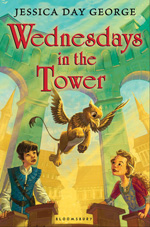 The sequel to Tuesdays at the Castle (2011), in which Princess Celie and her brother Rolf learned in the first book that Castle Glower has a mind of its own, this title shows that even a castle can change its mind. Before, The Castle only added or removed rooms on Tuesdays but now Wednesdays seem to have been added to The Castle’s agenda. In this new adventure, The Castle has created a new and hidden room that contains a bright orange egg. Rolf challenges Celie to find the new room, and when she does, she also discovers the egg. Celie cares for the egg and waits to see what will happen. One day, it hatches out a griffin that she names Rufus. With the exception of Bran the Wizard and Pogue the blacksmith, Celie manages to keep the existence of Rufus a secret. Celie tries to learn about griffins and their history within the castle and enjoys the fun of riding on Rufus’s back while pursuing her investigation. The ending leaves the story “hanging” (literally) and wide open for the next installment.
The sequel to Tuesdays at the Castle (2011), in which Princess Celie and her brother Rolf learned in the first book that Castle Glower has a mind of its own, this title shows that even a castle can change its mind. Before, The Castle only added or removed rooms on Tuesdays but now Wednesdays seem to have been added to The Castle’s agenda. In this new adventure, The Castle has created a new and hidden room that contains a bright orange egg. Rolf challenges Celie to find the new room, and when she does, she also discovers the egg. Celie cares for the egg and waits to see what will happen. One day, it hatches out a griffin that she names Rufus. With the exception of Bran the Wizard and Pogue the blacksmith, Celie manages to keep the existence of Rufus a secret. Celie tries to learn about griffins and their history within the castle and enjoys the fun of riding on Rufus’s back while pursuing her investigation. The ending leaves the story “hanging” (literally) and wide open for the next installment.
- Karen Hildebrand, Ohio Library and Reading Consultant
Rylant, Cynthia. (2013). The steadfast tin soldier. Illus. by Jen Corace. New York: Abrams Books for Children.
 It's terrific for a modern audience to have another version of the classic Hans Christian Andersen story of love between a tin soldier with one leg and a beautiful ballerina who perches on one leg. In this version of the story, a jealous goblin pushes the soldier from the window sill where his owner has perched him. From there, he goes on quite an adventure, sailing into a stream, meeting a rat who demands his passport, and then swept along further until being swallowed by a fish. When he somehow survives his perilous journey, his ballerina love is thrilled, but the goblin has one more trick up his sleeve, a fiery ending planned for the would-be lovers. Nevertheless, despite his treachery, true love triumphs over its many obstacles in this version of the tale. The watercolor, gouache, acrylic and pen and ink illustrations complement perfectly this timeless story of an unlikely romance. Although there is quite a lot of text, the story and the illustrations will hold readers' attention.
It's terrific for a modern audience to have another version of the classic Hans Christian Andersen story of love between a tin soldier with one leg and a beautiful ballerina who perches on one leg. In this version of the story, a jealous goblin pushes the soldier from the window sill where his owner has perched him. From there, he goes on quite an adventure, sailing into a stream, meeting a rat who demands his passport, and then swept along further until being swallowed by a fish. When he somehow survives his perilous journey, his ballerina love is thrilled, but the goblin has one more trick up his sleeve, a fiery ending planned for the would-be lovers. Nevertheless, despite his treachery, true love triumphs over its many obstacles in this version of the tale. The watercolor, gouache, acrylic and pen and ink illustrations complement perfectly this timeless story of an unlikely romance. Although there is quite a lot of text, the story and the illustrations will hold readers' attention.
- Barbara A. Ward, Washington State University Pullman
GRADES 6-8
Setterington, Ken. (2013). Branded by the pink triangle. Toronto, ON: Second Story Press.
 Much has been written about the atrocities of the Nazis during the Holocaust, but little has been written about the treatment of gay men during that time period. This book does an excellent job of describing the initial harassment of gay men by the Nazis as they tried to enforce Paragraph 175, a heretofore mostly ignored law passed in 1871 forbidding sexual contact between men. Eventually, anyone suspected as being homosexual was taken to a concentration camp and identified with a pink triangle worn on his clothing. The author describes the stories of some of the men who survived the horrible conditions in the death camps. Some young readers familiar with the play and movie Bent may be familiar with this aspect of the Holocaust, but most will have no idea of this form of discrimination. Young readers will now know this important piece of Holocaust history and understand the significance of the pink triangle, now the symbol of gay rights, once a mark of shame.
Much has been written about the atrocities of the Nazis during the Holocaust, but little has been written about the treatment of gay men during that time period. This book does an excellent job of describing the initial harassment of gay men by the Nazis as they tried to enforce Paragraph 175, a heretofore mostly ignored law passed in 1871 forbidding sexual contact between men. Eventually, anyone suspected as being homosexual was taken to a concentration camp and identified with a pink triangle worn on his clothing. The author describes the stories of some of the men who survived the horrible conditions in the death camps. Some young readers familiar with the play and movie Bent may be familiar with this aspect of the Holocaust, but most will have no idea of this form of discrimination. Young readers will now know this important piece of Holocaust history and understand the significance of the pink triangle, now the symbol of gay rights, once a mark of shame.
- Barbara A. Ward, Washington State University Pullman
GRADES 9-12
Lynch, Chris. (2013). Pieces. New York: Simon & Schuster.
 Returning to the characters created in Iceman (HarperCollins, 1994) the author returns readers to younger brother Eric, now 17, as he grieves the accidental death of his older brother, Duane, the previous year in a diving accident. Eric is lost without Duane who was not only his brother, but also his best friend. He mentally revisits that night in the hospital when Duane’s organs were harvested for other people in need. Now, a year later, as Eric contemplates his next steps in life including joining the Navy, he debates whether he wants to meet the recipients of Duane’s organs. He decides to attend a meeting where the recipients will be and is introduced to Phil, who is so grateful to have hearing now due to Duane’s inner-ear bones, to Barry who received the liver that he now seems driven to destroy through alcohol, and to Melinda who got a kidney that saved her life and allowed her to raise her child. Enter Martha, Duane’s former girlfriend and object of Eric’s teen crush, and these individuals become a sort of new family group for Eric. Complicated coming of age emotions make this a complex novel and study in characterization.
Returning to the characters created in Iceman (HarperCollins, 1994) the author returns readers to younger brother Eric, now 17, as he grieves the accidental death of his older brother, Duane, the previous year in a diving accident. Eric is lost without Duane who was not only his brother, but also his best friend. He mentally revisits that night in the hospital when Duane’s organs were harvested for other people in need. Now, a year later, as Eric contemplates his next steps in life including joining the Navy, he debates whether he wants to meet the recipients of Duane’s organs. He decides to attend a meeting where the recipients will be and is introduced to Phil, who is so grateful to have hearing now due to Duane’s inner-ear bones, to Barry who received the liver that he now seems driven to destroy through alcohol, and to Melinda who got a kidney that saved her life and allowed her to raise her child. Enter Martha, Duane’s former girlfriend and object of Eric’s teen crush, and these individuals become a sort of new family group for Eric. Complicated coming of age emotions make this a complex novel and study in characterization.
- Karen Hildebrand, Ohio Library and Reading Consultant
Lynch, Janet Nichols. (2013). My beautiful hippie. New York: Holiday House.
 It's 1967, the Summer of Love in San Francisco, and sixteen-year-old Joanne Donnelly lives right on the edge of the action in Haight-Ashbury. Her middle class upbringing leaves Joanne (Joni) feeling constrained and longing for more. She is drawn to Martin, a hippie panhandling on the street, and his particular lifestyle, even while fearing that he will be unfaithful to her and leave her. It’s clear almost from the start that this is a match not meant to be—despite the strong attraction between the two teens. Even as Martin introduces Joni to the counterculture, her older sister Denise has her own consciousness raised as the result of a disappointing early marriage. While capturing the sounds, sights, and feelings of this turbulent period in the nation's history, the author creates interesting characters that change over the course of the novel. Readers will be drawn to Joni and her determinately rebellious nature while noting that her searching didn't take her very far away from home. In many respects this is a quiet book, but it’s also the story of important life choices being made. Readers are certain to wonder what sort of adult Joni will become.
It's 1967, the Summer of Love in San Francisco, and sixteen-year-old Joanne Donnelly lives right on the edge of the action in Haight-Ashbury. Her middle class upbringing leaves Joanne (Joni) feeling constrained and longing for more. She is drawn to Martin, a hippie panhandling on the street, and his particular lifestyle, even while fearing that he will be unfaithful to her and leave her. It’s clear almost from the start that this is a match not meant to be—despite the strong attraction between the two teens. Even as Martin introduces Joni to the counterculture, her older sister Denise has her own consciousness raised as the result of a disappointing early marriage. While capturing the sounds, sights, and feelings of this turbulent period in the nation's history, the author creates interesting characters that change over the course of the novel. Readers will be drawn to Joni and her determinately rebellious nature while noting that her searching didn't take her very far away from home. In many respects this is a quiet book, but it’s also the story of important life choices being made. Readers are certain to wonder what sort of adult Joni will become.
- Barbara A. Ward, Washington State University Pullman
McMann, Lisa. (2013). Crash. New York: Simon Pulse/Simon and Schuster.
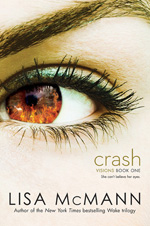 From the author of the popular Wake trilogy, Crash is the first title in her new Visions series. This first volume introduces readers to Jules and the DeMarco family. They own an Italian restaurant, and Jules is resigned to the fact that if she wants to drive to school, she must take the double-meatball-shaped food truck. Jules is starting to have visions, and everywhere she turns she pictures a terrible crash with a snowplow hurtling toward a building and an explosion resulting in nine body bags. Finally, after one vision she recognizes the face on one of the bodies, Sawyer Angotti, someone she knows and cares about deeply. With a history of mental illness in her family, Jules is reluctant to tell anyone about her visions. Although the visions are appearing everywhere, billboards, road signs, and television, she has to figure out a way to prevent this horrible accident from happening. McMann adds a bit of levity throughout this suspense-filled action novel as Jules is always creating her lists of 5 things she needs to think about and maybe act upon. This supernatural thriller is a great way to begin a new series from this popular author.
From the author of the popular Wake trilogy, Crash is the first title in her new Visions series. This first volume introduces readers to Jules and the DeMarco family. They own an Italian restaurant, and Jules is resigned to the fact that if she wants to drive to school, she must take the double-meatball-shaped food truck. Jules is starting to have visions, and everywhere she turns she pictures a terrible crash with a snowplow hurtling toward a building and an explosion resulting in nine body bags. Finally, after one vision she recognizes the face on one of the bodies, Sawyer Angotti, someone she knows and cares about deeply. With a history of mental illness in her family, Jules is reluctant to tell anyone about her visions. Although the visions are appearing everywhere, billboards, road signs, and television, she has to figure out a way to prevent this horrible accident from happening. McMann adds a bit of levity throughout this suspense-filled action novel as Jules is always creating her lists of 5 things she needs to think about and maybe act upon. This supernatural thriller is a great way to begin a new series from this popular author.
- Karen Hildebrand, Ohio Library and Reading Consultant
Winters, Cat. (2013). In the shadow of blackbirds. New York: Abrams/Amulet Books.
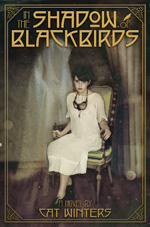 The cover of this book set in 1918 promises an enticing, independent, free-thinking protagonist with a plot revolving around spiritualism. Other black and white photographs, intriguing shots of mediums and possible visitors from the spirit world, soldiers in trenches during WWI, and images of citizens wearing masks to protect themselves from contagion, have been strategically placed within the narrative. Sixteen-year-old Mary Shelley Black has fled her Portland home for San Diego where her aunt lives. While her father is on trial for following his conscience, her aunt works hard to forget her own losses. Even as news of the war swirls around them, it is the flu that frightens everyone into staying home so they can avoid the contagion. Perhaps because there is so much death around them, many citizens are fascinated by the possibility of making connections with the spirits of their dearly departed. Mary Shelley scoffs at their gullibility, but when she feels the presence of Stephen, her childhood friend turned potential suitor, after his death, she decides she must figure out why his spirit refuses to rest. The original storyline and fascinating characters will keep even the choosiest reader engaged, and there are enough twists, turns, and bumps along the way to hold the attention of most readers. Effectively and hauntingly capturing the place and time in a surreal fashion, the author prompts reflection about the things we do to save face and whether the events described in the book could have happened. Readers will be unlikely to stop thinking about all those deaths as the result of the flu.
The cover of this book set in 1918 promises an enticing, independent, free-thinking protagonist with a plot revolving around spiritualism. Other black and white photographs, intriguing shots of mediums and possible visitors from the spirit world, soldiers in trenches during WWI, and images of citizens wearing masks to protect themselves from contagion, have been strategically placed within the narrative. Sixteen-year-old Mary Shelley Black has fled her Portland home for San Diego where her aunt lives. While her father is on trial for following his conscience, her aunt works hard to forget her own losses. Even as news of the war swirls around them, it is the flu that frightens everyone into staying home so they can avoid the contagion. Perhaps because there is so much death around them, many citizens are fascinated by the possibility of making connections with the spirits of their dearly departed. Mary Shelley scoffs at their gullibility, but when she feels the presence of Stephen, her childhood friend turned potential suitor, after his death, she decides she must figure out why his spirit refuses to rest. The original storyline and fascinating characters will keep even the choosiest reader engaged, and there are enough twists, turns, and bumps along the way to hold the attention of most readers. Effectively and hauntingly capturing the place and time in a surreal fashion, the author prompts reflection about the things we do to save face and whether the events described in the book could have happened. Readers will be unlikely to stop thinking about all those deaths as the result of the flu.
- Barbara A. Ward, Washington State University Pullman
These reviews are submitted by members of the International Reading Association's Children's Literature and Reading Special Interest Group (CL/R SIG) and are published weekly on Reading Today Online.